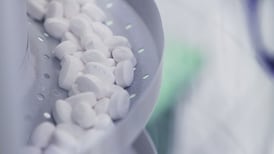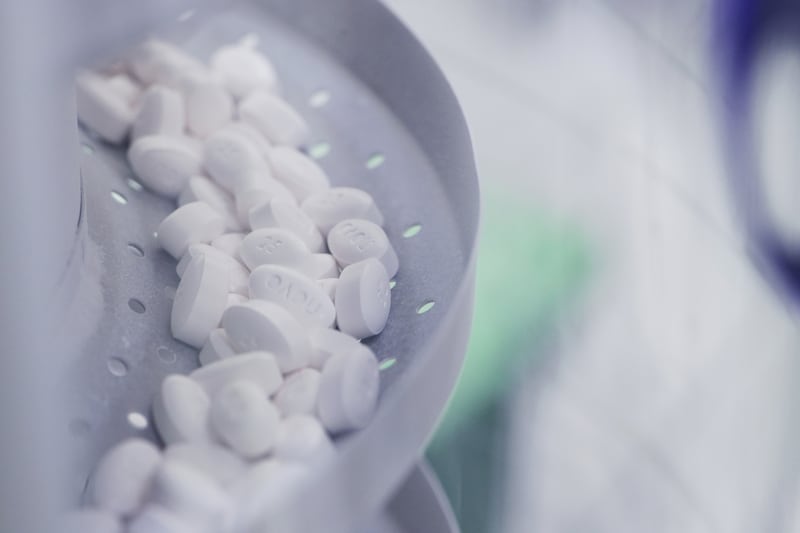Kenmare Resources broke an unusual record in 2020. The Irish titanium miner group moved an entire factory 22km from one part of its ore body in Mozambique, Africa, to another site.
“That was the heaviest mass ever lifted in Africa and the largest mass that has ever been transported that distance by road anywhere in the world,” its chief executive, Michael Carvill says proudly.
“And we had to build the road ourselves, through nothing, through bush. Nobody has done this ever before. Basically putting a factory on flatbed trucks, wide as a football pitch, seven storeys high, it took 48 hours. It took two years’ work and $127million capital expenditure.”
The move paid off. Kenmare’s Moma mine produced 1.55 million tonnes of ore last year, up from 800,000 in 2020, breaking its own record. Revenue hit a record $456 million last year from $243.7 million in 2020.
Pretax profits increased to $137.3 million from $22.8 million. Investors should benefit, too. The company will pay them total dividends of 32.7 cent a share, or $32.1 million for 2021, more than three times the 10c it paid for the previous year. It returned $81.6 million through a share buyback scheme in December.
Carvill explains that, traditionally, miners would have dismantled the plant, a key part of its operation, then moved the parts on trucks to the new site, where it would be reassembled. “Normally that takes 18 months and you have reduced production during that period; we’re the first that has ever done that,” he says.
Kenmare mines titanium, a light, strong, inert, metal favoured by golfers for clubs and aircraft manufacturers for components. But it is familiar to the rest of us also, albeit we don’t realise this.
In fact, we wear it and even eat it. Titanium has highest refractive index of any material except diamonds, meaning it reflects back most of the light shone on it. Consequently, about 95 per cent of it goes into pigments, which in turn end up in paints and dyes. “You use it anywhere where you need colour or opacity, even where that colour is black,” says Carvill.
He gestures around the bright conference room where we are sitting at its headquarters on Hatch Street Upper in Dublin 2. “All the surfaces in this room have titanium oxide pigment.”
It is in virtually all our clothes, plastic and packaging, cosmetics and toothpaste. And it does not stop there: it lends extra whiteness to milk, which would otherwise look grey, and is included in many processed foods. It is inert, so it is harmless.
So, it just makes things look nice? “Well,” Carvill counters, “it’s hard to think of a car not being painted right, but it’s not just looking right, you have to protect the metal underneath it.”
However, he concedes that as individuals in a particular country get wealthier, titanium oxide consumption rises as they tend to buy more things. So people in India use less of the metal than do those in the United States, which he says has the highest consumption per person.
Moma produces several different materials, all of which are titanium oxide. Its most important is ilmenite, which accounted for 1.14 million tonnes of 2021’s output. Kenmare is the world’s largest single producer of this mineral, accounting for 8 per cent of total supply.
The others are zircon and rutile. It also produces small quantities of mineral sands concentrate, which can be used to make rare-earth oxides from which permanent magnets, such as those used in electric motors, are made. While those are valuable, they’re just “a small component” of what Kenmare does.
The company's customers are mostly big pigment makers, including Chemours, a $6 billion specialist in titanium products, which US multinational Dupont spun off in 2015. Another is UK-based Venator. In fact, Carvill says virtually all the world's players in that business buy from Kenmare. "We've been in production now 15 years, we have a broad customer base," he notes.
Dredging
The Irish company mines by dredging. “We create a floating pond and our two dredges mine from the front edge of the pond. A dredge can mine in very high volumes, so then that pumps a kind of slurry back into a plant that floats behind it, a floating concentrate plant [the factory that Kenmare transported by road],” Carvill explains.
The concentrate plants have up to 3,500 spirals. As the material moves through these, the force pulls the lighter sands to the outside, so the heavier matter drops down through the structure, close to its axis.
“So at the bottom you have separation of the material you don’t want, which is 96, 97 per cent of what you have mined, and the small amount of material you do want, which is the titanium minerals,” he says.
Kenmare separates the minerals from the sands without using chemicals, acids or toxins. It is purely physical separation. It pumps the heavy minerals to another separation plant, where they are split from each other. It redeposits 96 per cent of the mined material at the back of the pond.
“It means that we’re effectively bringing the plant to the ore, unlike traditional mining, where you mine and you truck it to the plant,” Carvill points out.
The sand that Kenmare does not want simply goes in one end of the separation plant and out the other. It is a low-cost form of mining.
“The really good thing about it is that as you go through, the land that you leave behind is effectively the same piece of land that you’ve started with. We then recontour it, revegetate it, and then give it back to farming. So, say three years after we’ve gone through, it looks the exact same as before,” he says.
To top this off, Kenmare uses hydro electricity – from Cahora Bassa dam on the Zambezi river – which means much of its activities emit no greenhouse gas. It is not 100 per cent zero carbon, it uses bulldozers and other vehicles, but about 93 per cent of the power that the mine needs is generated this way.
Carvill complains that ratings agencies, which measure companies’ environmental and climate performance, do not give Kenmare the kudos it deserves for investing a huge amount of money years ago in a direct link to a hydroelectric plant, then learning to manage a volatile power supply.
“You’re rated not on where you are, we have very low carbon per tonne of product, but they say ‘We don’t care about that, what we want to know is how fast you’re getting down that last bit, what is your incremental rate of improvement?’,” he says. “So it’s sort of irritating, because if you’ve got loads of carbon per tonne per product, it’s sort of easy to get a bit down.”
Nevertheless, he’s enthusiastic about Kenmare’s $18 million plan to knock 12 per cent off its current emissions, partly because it solves a technical headache. “Our problem with running on hydro power is that the mineral separation plant is a very complex thing,” he says.
“For example, for zircon there are 27 different stages of separation. It’s like an orchestra. You have to get them all playing. Then, if they all have to stop and start again it takes a while to get them into synchronisation.”
Mozambique’s electricity grid is less than wholly reliable, according to Carvill, so there are dips and surges. Electrical storms during the country’s rainy season exacerbate this volatility.
“Because we have all these sensitive machines with controllers on them, they feel a dip and they say: ‘Okay, I’ve got to protect my motor: I’m going to shut it down.’ That shuts down the whole plant. That dip can be 30 milliseconds and it might take us four hours before we stabilise things again, and then you can have another dip.”
Consequently, Kenmare runs that plant on a diesel generator during the rainy season. However, the new project will end the need for this, cutting greenhouse gas emissions. “Basically you have a flywheel that has a lot of potential energy stored in its rotation,” Carvill explains.
“Then as the dip comes through, that flywheel drives a generator, an inductor, which induces power into the system, which fills in the dip for about three or four seconds.
“If it’s actually a full outage, or the dip lasts longer than that, then we have very large diesel engines linked to that, which then self-start in one second, and continue to operate until the power stabilises. The benefit for us is that we don’t have to burn fuel during that rainy period, and also we get protected through the rest of the year as well. We’re all very proud of the fact that we actually are a really low carbon producer. And this gets us lower.”
Mechanical engineer
Carvill’s obvious satisfaction with this project probably stems from his background. He trained as a mechanical engineer in Queen’s University Belfast before going on to complete an MBA at the Wharton School of Business in the US, where he did a dissertation on establishing a minerals mining development company.
When he returned to Ireland in the late 1980s he quickly got the chance to put that into practice. Finnish state miner Outokumpu had bought Tara Mines, leaving investors in Dublin with a keenness for resources, creating up to 17 new companies. Most were focused on exploration, but the engineer in Carvill was more interested in how to get something out of the ground.
He, his father and other investors started with €38,000. They needed to raise money from the market and found the dormant Kenmare Oil Exploration, set up to find oil in an offshore block that turned out empty. They took it over, with Carvill as chief executive, and changed its name.
Last year, high prices further boosted revenue that grew on the back of increased production. From quarter to quarter, demand for Kenmare's products increased, a pattern that has so far continued into 2022. It has not all been plain sailing for the company. Between 2012 and 2016 additional mines in China increased titanium ore supplies, pushing prices down. That took several years to work through the system.
Demand continued growing but the low prices deterred investment in new production. Carvill does not see any immediate threat of a repeat. Existing Chinese operations will probably increase production at 3 to 4 per cent a year, while there are no big new projects on the horizon.
“At the minute we don’t see it as imminent that there will be such an increase in supply to tip the market into oversupply,” he says. “On the other hand, it’s a commodity, and commodities do go in cycles, so eventually there will be a down cycle.”
Kenmare’s insurance against this is to try to ensure that it is among its industry’s lower-cost producers.
Russia's invasion of Ukraine, with the subsequent sanctions and surge in inflation, caused mainly by rocketing energy prices, poses more immediate risks to business generally. Kenmare has no Russian customers, so boycotts will have only an indirect impact. Ukraine produces about 4 per cent of world titanium supplies, so that could have ramifications also.
Carvill argues that no one really knows what will happen. “I just think it’s just a tragedy and let’s not predict what’s coming out of it, misery is coming out of it,” he says.
Ukraine followed quickly on the heels of Covid-19. That posed its own challenges to Moma, which continued operating through the pandemic. Like everyone else in early 2020, no one in Kenmare really knew what was happening, Carvill recalls.
“What we did say is ‘What we don’t want to do is we don’t want the mine to be a vector of this disease, bringing it in to that local community and we want to not be affected ourselves’.”
Anyone on site at Moma at that time could stay, anyone who was not could not return. He hastens to point out that that did not mean people could not leave, they could, but they could not come back. No one lost their job, they just could not work for a period.
“That was in the middle of the project to move the mineral concentration plant, so for about six months before things regularised a little bit, plenty of people did six months on the site, working pretty much every day, in three shifts doing the work of four shifts. It’s a great performance, it’s really remarkable.”
Kenmare had social distancing, hand-washing and mask-wearing. The company donated personal protective equipment and ventilators to the local community. When vaccines arrived last year, the company agreed with the local health service that it would buy them for its own workers and provide 12,000 doses to people in the area. “We’re proud of what we did last year,” says Carvill.
********
CV
Name: Michael Carvill
Post: Chief executive, Kenmare Resources
Why is he in the news? Titanium miner Kenmare Resources recently announced record revenue and profits for 2021
Family: Married with three children
Interests: Skiing and sailing
Something we might expect: His MBA dissertation was on developing a minerals mining business
Something that might surprise: He did that MBA in Wharton School of Business in the US


















